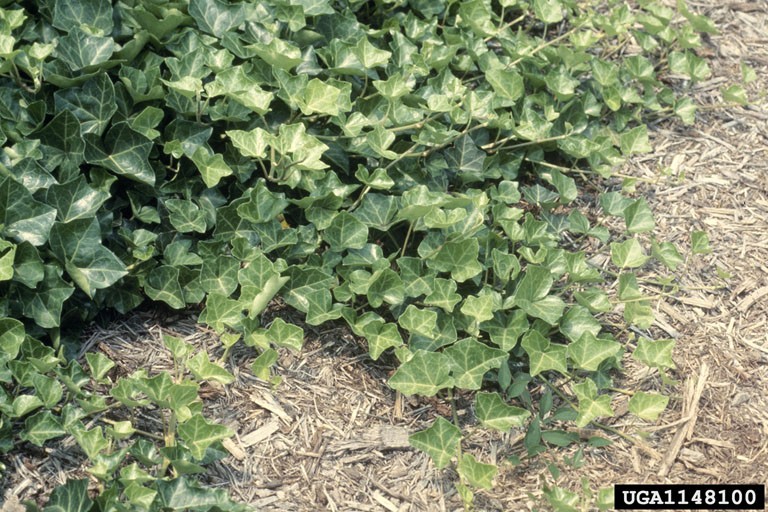Hedera helix
English Ivy
Class: Magnoliopsida
Order: Apiales
Family: Araliacaeae

Photographer: USDA APHIS PPQ Archive
Source: Bugwood.org
Description
Hedera helix is from the Ginseng family and can grow in two forms. In the juvenile stage, it is an evergreen and perennial vine that can grow up to 100 feet, or however tall the tree is in which it climbs. When the ivy is mature it is then able to produce flowers and fruit; after about 10 years of growth, the ivy transforms into a shrub-like plant. Leaf shape is variable and depends on the age of the plant but the three-lobed form is the most commonly recognized. The leaves are simple, alternate and are a deep, glossy green, with a waxy to leathery-like cuticle; and they have an odor when crushed. The plants exit the juvenile stage when they reach the reproductive phase. They grow a woody stem from the ground or from a climbing vine to then create the shrub structure. Leaves on the shrubby stems are a lighter green, oval and not lobed. Young shoots and leaves are hairy and scaly, but older plants are glabrous. Hedera helix grows fastest in the vine stage. The flowers are about .3inches wide with five white or yellowish-green petals. The fruit look like wild grapes but they have small protrusion coming from them. Within the fruits are 1-5 stone-like seeds and if they are not eaten by birds the fruit can remain on the vine throughout the winter.
Ecological Threat: Hedera helix has become a serious problem in some areas because it can cover plants and trees and halt their normal succession. Also, this plant can threaten all layers of the forests and in open areas, both the ground and canopy. It can inhibit a generation of native plants by shading the soil and preventing herbs and seedlings from growing, and in turn causing destruction within the forest ecosystem. English Ivy can also kill trees by growing up the trunks and eventually overtaking the canopy and preventing the tree from acquiring sun that it requires. Wildlife is affected by the altered ecosystems, and the leaf litter changes the nutrient content of the soil. Glycosides are toxins present in the fruit of the English ivy. Those chemicals can induce vomiting, diarrhea and dermatitis in sensitive individuals. Some symptoms are more serious, such as, coma, fever, muscular weakness and lack of coordination. Finally, English Ivy is hosts for the pathogen, bacterial leaf scorch (Xylalla fastidiosa), which affects native and ornamental trees like elms, oaks and maples.
Biology: Hedera helix primarily reproduces vegetatively but it does also produce a large number of seeds. Any stem fragment that comes into contact with the soil will sprout and flowers are pollinated by flies and bees in the fall, when few other plants are flowering. Birds eat and disperse the seeds, and the seeds must be scarified by the bird’s digestive tract to germinate. However, the toxic glycosides in the seeds often cause the bird to vomit.
History: The English ivy was thought to be brought over as an ornamental in the early colonial years. It remains as a popular ornamental because it is dependable, evergreen groundcover requiring little maintenance. It is cold tolerant and is pest free; however, it has allelopathic effects and kills off other ground-growing plants.
U.S. Habitat: In North America, this plant can invade open forests, fields, hedgerows and coastal salt marshes recently disturbed by humans.
Distribution
Native Origin: Thought to be native to Western or Mediterranean Europe.
U.S. Present: AL, AR, AZ, CA, DC, DE, FL, GA, HI, ID, IL, IN, KY, LA, MA, MD, MI, MO, MS, NC, NJ, NY, OH, OK, OR, PA, SC, TN, TX, UT, VA, WA, WV
Resembles/Alternatives
English ivy has hundreds of horticultural varieties (400+) and native climbers like the wild grape can resemble the English ivy variations. However, the wild grape can be distinguished by having climbing tendrils and large three-lobed leaves with toothed margins, and the grapes are smooth and not knobbed like English ivy fruits. It also resembles other invasive species like the Chinese yam, Porcelainberry and various other ivy (Persian, Irish and Boston) species. But the English ivy can be distinguished from these other species by being a non-deciduous ivy and/or the size of the leaves.
Management
Unfortunately, most of the research that has gone into this plant has been for creating new cultivars and not for managing it. The best control strategy is to not plant it at home. Cutting or hand-pulling can be an effective control measure, but one must be careful to protect themselves from the plants potential toxic effects. The entire plant, including roots and runners, must be removed; because stem fragments can cause re-sprouting. Also, English ivy is tolerant of pre-emergent herbicides and because of the waxy cuticle on the leaves it is resistant to post-emergent herbicides also. Glyphosate may be useful on young plants, and triclopyr may be effective when most of the top growth of leaves is removed. Cutting the stems prior to herbicide application facilitates chemical control. Winter treatments are less effective because the plant is growing more slowly.
References
Hausen, B. M., Bröhas, J., König, W. A., Faasch, H., Hahn, H., & Bruhn, G. 1987. Allergic and irritant contact dermatitis from falcarinol and didehydrofalcarinol in common ivy (Hedera helix L.). Contact Dermatitis, 17(1), 1-9.
Metcalfe, D. J. 2005. Hedera helix L. Journal of Ecology, 93(3):632-648.
Woodward, Susan L., and Joyce Ann. Quinn. 2011. English Ivy. Encyclopedia of Invasive Species: From Africanized Honey Bees to Zebra Mussels. Santa Barbara, CA: Greenwood. 602-06. Print.
Internet Sources
http://extension.oregonstate.edu/gardening/node/948
http://www.ecosystemgardening.com/english-ivy-most-hated-plants.html
http://www.ncsu.edu/goingnative/howto/mapping/invexse/englishi.html
http://www.nps.gov/plants/alien/fact/hehe1.htm
 Texas Invasive Species Institute
Texas Invasive Species Institute